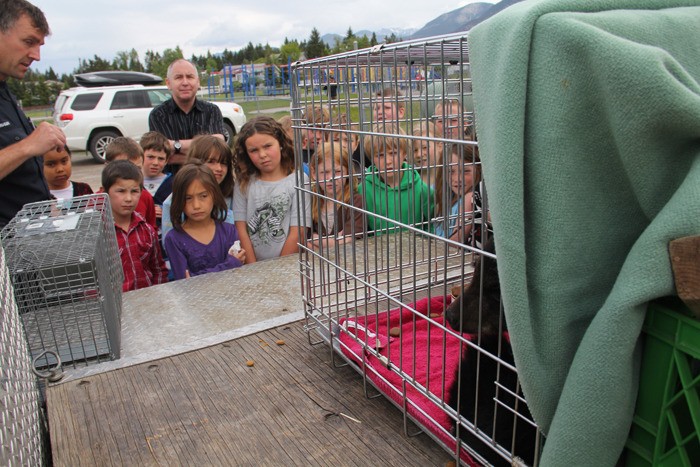An orphaned bear cub found on Westside Road south of Invermere is being transported by air to Smithers today (May 30) for rehabilitation at the Northern Lights Wildlife Society (NLWS) shelter.
The baby male black bear is estimated to be ten to twelve weeks old and had been on its own for approximately two weeks prior to being captured on Tuesday (May 29) morning, said Invermere conservation officer Greg Kruger.
“We were monitoring it for the first few days just hoping the mother would come back,” Kruger said, “but after a few days of it being seen by itself, we had a good indication it was orphaned for whatever reason.”
After its capture, the bear cub was diagnosed as malnourished but otherwise healthy at the Invermere Veterinary Hospital by Dr. Mark Zehnder, who drove the cub to Cranbrook International Airport this morning for its transit to Smithers after it spent the night in the hospital’s overnight kennels.
But before leaving the valley, the orphaned bear made the rounds to Windermere, Eileen Madson Primary, and J A Laird elementary schools yesterday afternoon when each student had the chance to see it sitting in a small cage in the back of Kruger’s pickup truck and ask the conservation officer questions.
“I wanted all the kids to have an opportunity to see a wild bear cub,” Kruger said. “Mainly, I just wanted to give all the young students of Invermere a little bit [of a] better connection with wildlife.”
Conservation officers were made aware of the bear by public reports of sightings four kilometres south of Invermere along Westside Road.
It took almost a week before the cub was successfully captured. A larger live trap proved useless as the baby bear was not heavy enough to trigger the door to shut. Attempts to scoop the cub by hand as it scurried through underbrush also proved futile.
“We knew it was going in and feeding in the trap, so just yesterday we put a smaller trap and he went in that,” Kruger said, “He’s very healthy, very agile and still quite wild, and fast so I was never able to get close enough to just with a blanket to grab it.”
Nothing has been learned about the mother, but since the cub was found near a roadway, she could have been involved in a collision with a vehicle. However, if the mother was dead, a cub this age would have stayed with her body unless the body was taken, said Kruger.
“We also have hunting season right now,” he said. “It’s against the law for anyone to harvest a bear that’s in a family group, but we can’t say for sure.”
Another possibility is that it was abandoned by its mother if he was the runt of the litter, he added.
The mission of the NLWS is to offset the human impact on orphaned wild animals, NLWS co-founder and manager Angelika Langen told The Valley Echo. Bears that go into rehabilitation are usually orphaned due to human intervention, but sometimes it’s because of natural causes, she said.
This isn’t the first time the shelter has accepted an Invermere bear. Two years ago, one arrived before Christmas that was slightly older and near-starving.
The shelter is currently housing eight baby bears as well as 25 cubs from last year that are ready for release, They’re kept divided by region which makes transporting them back for release much easier, Langen said.
“Next year in the spring we will be bringing the bear back and it will be released in the Invermere region again,” Langen said. “Right now, [the Invermere cub] will go in with the cub from Chase so then when we drive down we’re going to stop in Chase, let the Chase cub go and then carry on to Inveremre and then at least they have some company on the trip.”
Anyone interested in keeping track of the cub’s progress can do so. THe NLWS posts regular video and picture updates of the animals in their care on their website and Facebook group page. The society is currently fundraising for a live web cam they hope to have installed this summer.
“I put it on the Facebook group that I need somebody to babysit a bear in Vancouver for four hours and within a couple of hours I had a person who had volunteered so it’s a group effort,” said Langen. “We gave them instructions to feed it dandelion, just to staibilize it in between flights.”
The orphaned cub had a four-hour layover in Vancouver between flights. It flew Cranbrook to Vancouver on Pacific Coastal Air then to Smithers with Hawk Air — both companies donated the flights.
All animals at the NLWS shelter are given a name, usually one suggested on the society’s Facebook page that receives the most likes. But Kruger said there was strong interest on the part of the students to name the Invermere bear themselves, and that he would be co-ordinating bringing forward a local name by the elementary schools.
To follow the bear’s progress and for more information on the NLWS, visit www.wildlifeshelter.com. Stay tuned to www.invermerevalleyecho.com for an update on the bear and its name.
